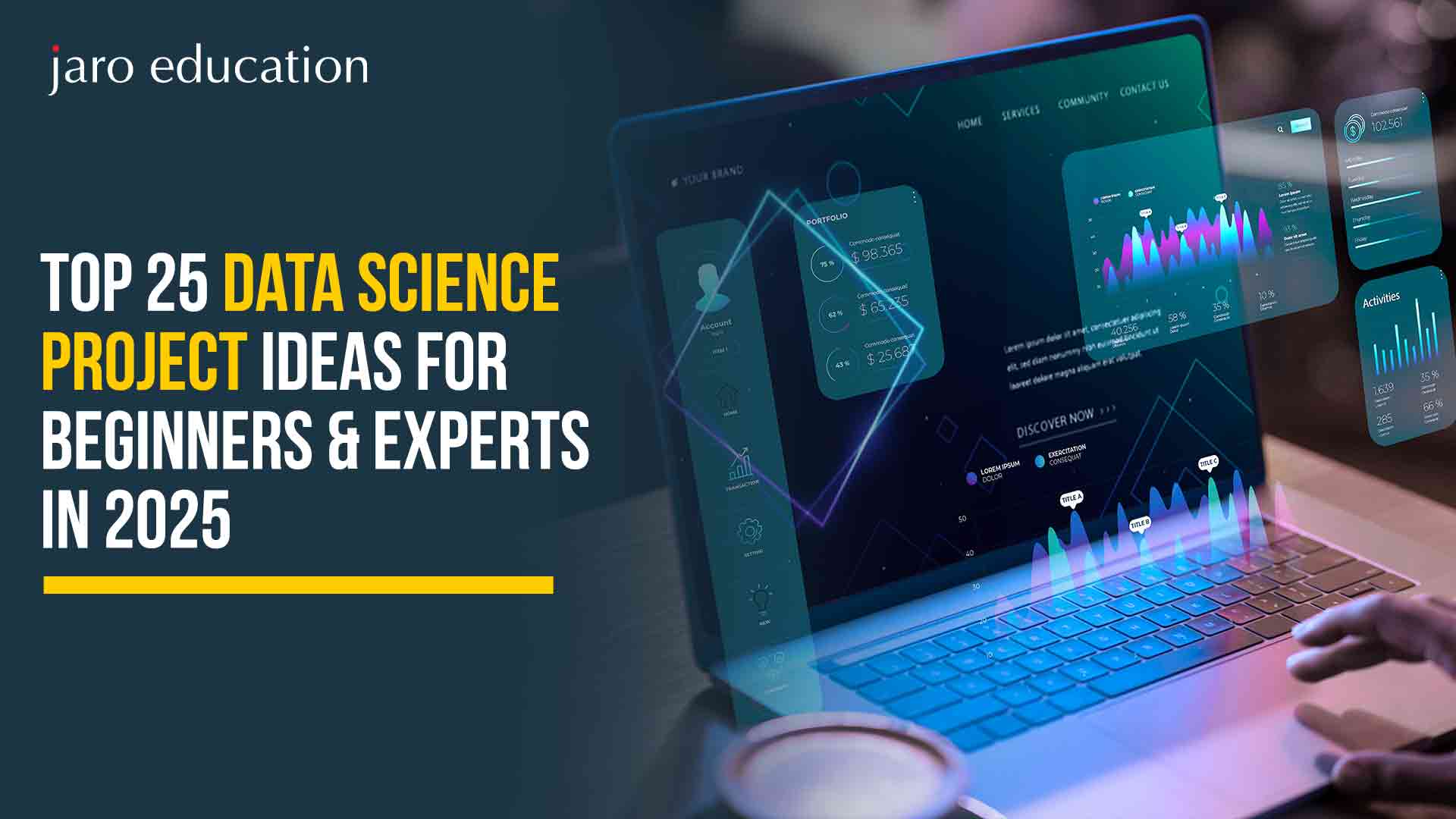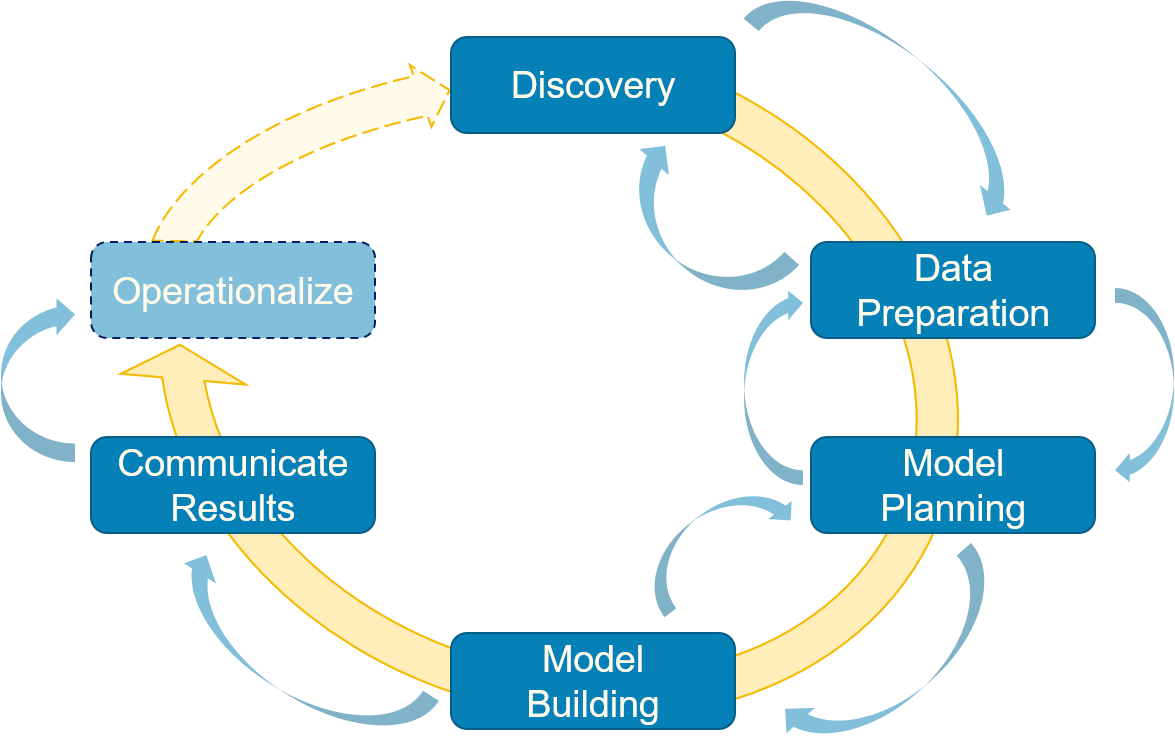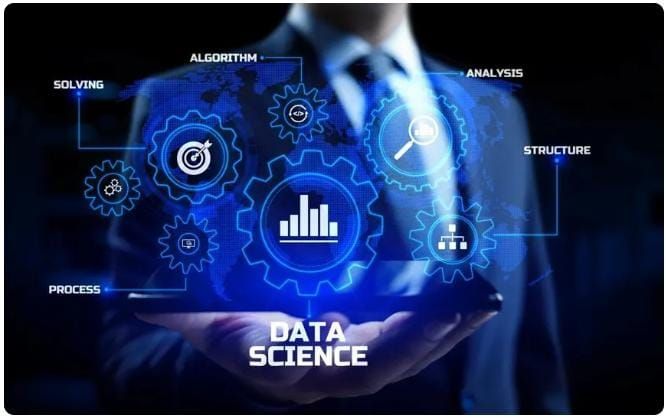Top 25 Data Science Project Ideas For Beginners & Experts in 2025
Table of Contents

- jaro Education
- 21, February 2024
- 10:00 am
The demand for data science skills continues rising as organizations increasingly realize the value of extracting insights from data to guide strategy. However, becoming an expert data scientist requires moving beyond textbook concepts to gain hands-on experience through real-world data science project ideas. This blog provides a comprehensive guide to data science project ideas tailored for beginners and experienced professionals.
Basics of Data Science

*GeekforGeek
Mastering the fundamentals, including data science project idea types, quantitative methods, programming languages, and modeling, lays the groundwork for data science project idea mastery. Let’s understand them better.
1. Data Types and Wrangling
Grasping the fundamental concepts in data science courses is vital before applying them to Data Science project ideas. Core ideas that beginners should comprehend include types of data, basic quantitative methods, popular programming tools, general machine learning workflow, and evaluation metrics.
The data science course leverages both structured and unstructured data. Structured data includes tabular formats like spreadsheets and SQL databases with predefined fields. On the other hand, unstructured data science project ideas encompass images, texts, audio, and videos without confirming formats. Methods to wrangle different data science project ideas types should be understood.
2. Mathematical Foundation
Quantitative methods form the mathematical foundation. Descriptive statistics, data visualization, correlation, and statistical testing are crucial for initial data analysis. Probability, algorithms, and optimization techniques enable the building of ML models. Linear algebra and multivariable calculus power advanced analytics.
3. Tools and Languages
Python has become the most popular programming language for data science courses. Core libraries like NumPy, Pandas, and Matplotlib and machine learning frameworks like Scikit-Learn and TensorFlow should be learned. Other languages like R and tools like SQL, Hadoop, and Spark have specific utilities for analytics tasks.
4. Model Building and Evaluation
The standard machine learning workflow involves data collection, cleaning, and feature engineering, followed by choosing a suitable model, training/testing, and performance evaluation. Algorithms for supervised learning, like regression and classification, and unsupervised learning, like clustering and dimensionality reduction, should be tested across data science project ideas to understand their working and appropriate applications.
Data Science Project Ideas- Selection Criteria
Selecting the right data science project ideas is key to improving data science course skills. Beginners should focus on developing core abilities like data preparation, visualization, and basic machine learning models. Exploratory analysis, classification systems, and recommendation engines allow hands-on practice of end-to-end techniques while aligning with interests.

*GitHub Page
Experienced professionals should choose the best data science project ideas that demonstrate specialized skills. Data engineers can work on large-scale pipeline solutions. Machine learning experts can implement complex deep learning for natural language or image analysis. Picking data science courses within their focus areas allows experts to grow niche expertise.
Best Project Ideas in Data Science For Beginners
Hands-on data science project ideas help beginners gain data science course skills for their portfolios. They can choose the best data science project ideas that match their interests while learning data cleaning, analysis, visualization, machine learning, and more. Best data science project ideas for beginners include:
1. Exploratory Data Analysis
A key skill for data scientists is the ability to analyze and extract insights from any new dataset. A great data science project idea involves loading a dataset, inspecting it for missing values and anomalies, cleaning the data, summarising key attributes, and visualizing variables through plots to find patterns. Useful Python libraries include NumPy, Pandas, Matplotlib, and Seaborn. Exploratory analysis is crucial for understanding the data science course before applying ML algorithms.
2. Customer Churn Prediction
Customer churn modelling uses classification techniques to identify customers likely to cancel a subscription. Using a sample churn dataset from Kaggle containing customer attributes, you can preprocess the data science course and train logistic regression, decision trees or random forest models. Evaluate models with a confusion matrix, classification reports, ROC curves, and precision-recall values. The end goal is to predict customers who may churn and take action to retain them.
3. Movie Recommender System
Recommender systems suggest relevant products using correlation techniques or content filtering on sample data. A movie recommender using Python libraries like Pandas and Scikit-Learn can apply correlation between users/movies to make personalized suggestions. Alternatively, natural language processing on plot summaries and metadata can also filter and recommend movies with similar content.
4. Fake News Classifier
Fake news spreads false information framed as legitimate news. Using NLP and ML on satire/scam datasets, you can build models to identify fake news articles. Extract text from best data science project ideas and engineered features to train classifiers like logistic regression, naive Bayes, and SVM using Python’s NLTK, SpaCy, and Scikit-Learn. Evaluation metrics include accuracy, precision, and recall. Deploying these models can help mitigate the spread of misinformation.
5. Stock Price Prediction
Applying time series analysis to historical stock data science project ideas can forecast future direction and prices. Using Python libraries like NumPy, Pandas, and Matplotlib, analyze the time series in a data science course, preprocess it, and extract features. Then train ARIMA, Prophet models or LSTM neural networks to make stock price predictions. Evaluation involves metrics like MAE, MSE and directional accuracy. This has applications in algorithmic trading strategies and investment decisions.
6. Image Recognition with Convolutional Neural Networks
Image classification is a common computer vision task. Convolutional neural networks (CNNs) are especially effective for identifying and labelling objects in images. Beginners can use Python along with frameworks like TensorFlow and Keras to train CNN models. Some good image datasets to practice on are MNIST (handwritten digits), CIFAR-10 (10 categories of objects) and ImageNet.
7. Chatbot for Customer Service
Chatbots leverages machine learning to provide customer support automatically at scale. Beginner data science project ideas from scientists can train sequence-to-sequence recurrent neural network models like LSTMs on datasets of customer queries mapped to responses. This allows the chatbot to learn response generation based on question patterns. Python libraries like NLTK and spaCy can preprocess text data science courses for model input.
8. Sentiment Analysis with Machine Learning
Sentiment analysis aims to computationally detect if a text expresses positive, negative, or neutral opinions. For instance, reviews of products can be algorithmically classified as conveying satisfaction or disappointment. Using a dataset of customer reviews, Python’s machine learning stack Scikit-Learn can build classifiers like logistic regression and Support Vector Machines (SVM) after the text data is cleaned, tokenized, and vectorized with Python’s NLTK library.
9. Predictive Maintenance
Critical equipment like engines need regular upkeep before failure to minimize downtime. A historical time series of data science project ideas from sensors can be used to predict maintenance needs even before errors emerge. Data science course preprocessing followed by time series forecasting models in Python like ARIMA and Prophet can uncover trends and seasonal failure patterns to schedule proactive upkeep.
10. Customer Segmentation
Customer segmentation uses clustering algorithms like K-Means to group customers into categories based on attributes like demographics and purchasing behaviour from sample datasets. This provides customized marketing and product recommendations for segmented groups and the evaluation uses silhouette analysis and Elbow plots.
11. Music Recommendation Engine
Music recommenders suggest songs based on a user’s listening history and audio features of songs. Collaborative filtering analyses listening patterns, while content-based filtering uses audio features extracted from Python libraries like Librosa. Recommendation quality is measured by mean average precision and recall. This can be used to create personalized playlists.
12. Fraud Detection
Fraud detection aims to identify anomalies and irregular patterns in transactions that may indicate fraudulent activity. Fraud can be detected using outlier detection and cluster analysis techniques on sample datasets. This helps financial institutions recognize fraud early.
13. Bike Rental Demand Forecasting
Historical bike rental demand can be modelled with time series techniques to forecast future demand. Data preprocessing followed by SARIMA and FB Prophet models using Python can predict bike rental patterns. This rental demand prediction helps optimize inventory.
14. Text Summarisation
Text summarisation generates a concise summary while preserving key information and context. Using Python’s NLTK and Gensim, important sentences can be ranked algorithmically from text corpus based on frequency, position and similarity. Abstractive techniques using seq2seq models also generate new summaries.
15. Web Scraping and Analysis
Important data can be extracted from websites through web scraping using Python libraries like Beautiful Soup. Scraped data when cleaned and analyzed using Pandas, Matplotlib provides valuable insights. On the other hand, real-world web analytics enhances business intelligence.
As beginners complete end-to-end data science project ideas across these domains, they gain valuable hands-on data science skills and experience.
Data Science Project Ideas For Experts
Advanced data science project ideas for experienced data professionals include:
1. Predicting Car Resale Value
Forecasting used car prices helps buyers and sellers. Collecting car make, model, year, mileage, location, etc., and applying regression models like random forest, and XGBoost using Python/R can predict resale value. With that, advanced ensembling can improve predictions, and deploying this as a web app guides pricing decisions.
2. Conversational AI Chatbot
Building production-ready conversational chatbots requires speech recognition and deep learning for natural language processing. Python libraries like Tensorflow, Keras, and PyTorch can train neural networks on conversational data. Deploying the chatbot with streamlined voice and dialogue capabilities improves customer experience.
3. Object Detection in Images
Object detection identifies objects within images and localizes them with bounding boxes using deep neural networks like R-CNN, SSD, and YOLO. Using frameworks like TensorFlow, you can train and optimize these complex models on image datasets to accurately detect various objects. This has applications in autonomous vehicles, surveillance, etc.
4. Text Generation
Generating synthetic coherent text is possible by training recurrent neural networks on large text corpora. Models like GPT-2 in Python using TensorFlow can learn statistical patterns in sentences and generate new text matching human writing style. Applications involve content creation and augmentation.
5. Predicting Employee Attrition
HR analytics predicts employee retention probability using historical tenure data and attributes like performance, compensation, and demographics. Python tools like Scikit-Learn can build interpretable models like logistic regression, decision trees, and SHAP values on employee data for attrition insights. This identifies retention risks.
6. Recommender System with Neural Networks
Specialized neural network architectures can provide accurate recommendations. Autoencoders, RNNs, and Graph Networks built using Python libraries like Keras, and Pytorch can model user-item interactions for collaborative filtering-based recommendations. Optimization and scalability need to be handled for large datasets.
7. Sales Forecasting
Sophisticated multivariate models are required for accurate sales forecasts. Using Python, advanced regression models like ARIMA, and Prophet and machine learning algorithms like XGBoost, and LSTM networks can incorporate multiple sales drivers for robust forecasts.
8. Click-Through Rate Prediction for Ads
Estimating click-through rates for ads helps digital marketers. Factors like ad creative, copy, landing page, user demographics, etc. can feed into gradient-boosted decision trees and neural network models built with Tensorflow/Keras to predict ad CTRs. Improving CTRs raises the ROI of campaigns.
9. Cyberbullying Detection
Detecting cyberbullying in social media posts using deep learning techniques can help maintain online civility. Specialized CNNs and RNNs using word embeddings can identify bullying in text and comments. These models need extensive training in data science courses covering nuanced cases. Moderation improves with automated flagging of potential bullying.
10. Image Caption Generator
Generating captions for images involves encoder-decoder CNN-RNN models. Using libraries like TensorFlow and Keras, the CNN encodes the image, which the LSTM model decodes into appropriate captions by learning from image-caption datasets. This has applications in assistive technology for visually impaired users.
Such data science projects for the final year allow students to apply specialized modeling, deep learning, and other advanced techniques to build real-world systems. Key challenges involve data science courses, robust pipelines, optimization, and deployment. Experts can constantly expand data science course boundaries through impactful data science project ideas demonstrating business value.
Best Data Science Course Topics

An outline for data science courses remains the same, with varying decisions on whether to pursue online courses, tried-and-tested land-based classrooms, or full-time university degrees. That said, data science project ideas work in every course may differ; it should adhere to the common core topics of data science course, which are listed below:
| Data Visualization | Data Visualization is presenting data science courses in a graphical or visual format for the clear and efficient communication of information. It employs tools such as charts, graphs, and maps to assist users in understanding trends, outliers, and patterns in data. |
| Machine Learning | This is a subset of AI enabling the learning ability of a system from experience to improve performance. It covers algorithms for classification, regression, clustering, and recommendation systems. |
| Deep Learning | Deep Learning applies multi-layered neural networks for examining large-scale data. These are key to functioning image/speech recognition and natural language processing applications, as well as assisting with the development of self-driven vehicles-complex pattern-based data analysis. |
| Data Mining | Data Mining consists of extracting meaningful value out of large amounts of data to identify patterns, correlating information, and establishing trends. A compilation of machine learning, statistics, and database systems, this aims at drawing actionable knowledge from a data science course. |
| Programming Languages | Some of the important programming languages for data science course applications include Python and R. While Python is easy to learn and has a large number of libraries for data work (such as Pandas and NumPy), R is more specialized in statistical analysis and graphical modeling. |
| Statistics | Critical in data science courses for analyzing data and making predictions, statistics offer some of the tools-and-descriptive statistics, inferential statistics, testing of hypotheses, and statistical models and methods. |
| Cloud Computing | Cloud Computing gives you scalable resources to store, process, and analyze large datasets in data science courses. AWS, Google Cloud, and Azure, among other services, provide platforms to deploy machine-learning algorithms and big data processing. |
| Exploratory Data Analysis (EDA) | It is a process of analyzing data sets to summarize their main characteristics, often with the help of visual methods. It is a vital step for a data scientist before formal model building because the EDA process usually helps find patterns, anomalies, and relationships in the data science course. |
| Artificial Intelligence | AI includes all methods that allow machines to imitate human intelligence in reasoning, learning, and problem-solving. It is an extensive field that encompasses machine learning, deep learning, and other algorithms. |
| Big Data | It comprises a massive data science course, computationally analyzed to identify patterns, trends, or correlations. It is characterized by volume, velocity, and variety, which put challenges on traditional data processing tools in terms of complexity and scalability. |
| Data Structures | Data science courses are various methods to organize and structure a particular set of data for efficient access and modification. Focused on those arrays, lists, trees, and graphs, which are crucial in optimizing algorithms in data science course. |
| Natural Language Processing (NLP) | NLP is the cross-section of computer science, AI, and linguistics aimed at aiding computers to understand, interpret, and generate human language. |
| Business Intelligence | BI is related to the process of analyzing business data to produce actionable insights, which encompasses data aggregation. |
| Database management | Database management refers to any process and technology associated with overseeing, storing, and retrieving data from databases. This upholds the data's integrity, security, and availability. |
| Linear algebra | Linear algebra is a fundamental branch of mathematics that concerns the study of vector spaces and the linear transformations between them. It serves as a keystone upon which machine learning and related disciplines build, equipping them to manage and analyze data science courses. |
| Linear regression | A statistical technique used to analyze the relationship between a dependent variable and one or more independent variables to predict future outcomes or make inferences. |
| Spatial sciences | Spatial sciences examine phenomena integrated with the location, distance, and area of earthly objects. These fields employ mapping, GIS, and spatial analysis. |
| Statistical inference | It concerns making inferences concerning the larger population via observations drawn from a smaller sample. Typical procedures include estimating population parameters, hypothesis testing, and establishing confidence intervals. |
| Probability | Probability, as that branch of mathematics that predicts the chance of an occurrence of an event, has great importance in statistical analysis and in modelling the uncertainties concerned in data science courses. |
Finding the Correct Data Science Courses through Jaro Education
Jaro Education recognises that many individuals struggle to find avenues for enrolling in data science courses suited to their level of expertise. Here are some ways this institute can assist you:
Since Jaro Education collaborates with top universities and institutions, their programs are generally backed with aligned structure and continuing support of the operationally set industry demands. Here is how it can help:
- Programs by the Top Institutions: Jaro Education presents programs from well-reputed schools and universities, assuring that you are entering a course that provides basic foundations and advanced skills. For instance, in case you seek one course in machine learning or AI, Jaro Education must have some focused programs developed with institutions such as IIMs, IITs, or IVY-League institutions.
- Diverse Learning Paths: Depending on your background and interests, Jaro Education offers a diverse portfolio of high-quality programs—from undergraduate and postgraduate degrees to executive education certifications tailored for industry leaders. Whether you’re looking for foundational data science courses, specialized tracks in machine learning, AI, and deep learning, or executive training designed for professionals transitioning into data science, Jaro provides programs to match your career aspirations.
- Skills in Demand in Industry: The highly sought-after Data Science course from top-ranked institutions, offered through Jaro Education, equips you with relevant skills to stay ahead of current market trends.
Conclusion
Beginners can learn core data science project ideas skills, and experts can broaden proficiency through tailored data science project ideas spanning predictive modeling, deep learning, and other techniques. With perseverance and willingness to incrementally improve, data science courses for learners at all levels can advance through hands-on, practical experience. Readers can use these best data science project ideas as starting points and customize efforts based on available data science courses and business needs.
Frequently Asked Questions
Start by identifying real-world problems in industries like healthcare, finance, or e-commerce. Look for areas where data can drive insights or improve decision-making. Explore datasets on platforms like Kaggle, UCI Machine Learning Repository, or government open data science course portals for inspiration. Additionally, consider building data science project ideas around trending technologies like machine learning, deep learning, or natural language processing (NLP).
Datasets are available on websites like:
- Kaggle (variety of datasets for different problem domains)
- UCI Machine Learning Repository
- Google Dataset Search
- Data.gov (US government datasets)
- OpenData platforms from organizations like the World Bank or WHO.
Common tools include:
- Languages: Python (pandas, numpy, matplotlib, scikit-learn) or R
- Libraries: TensorFlow, Keras, PyTorch (for deep learning)
- Platforms: Jupyter Notebooks, Google Colab
- Visualization: Tableau, PowerBI, or Plotly for creating interactive visualizations.








